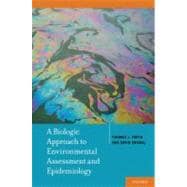
Note: Supplemental materials are not guaranteed with Rental or Used book purchases.
Purchase Benefits
Looking to rent a book? Rent A Biologic Approach to Environmental Assessment and Epidemiology [ISBN: 9780195141566] for the semester, quarter, and short term or search our site for other textbooks by Smith, Thomas J.; Kriebel, David. Renting a textbook can save you up to 90% from the cost of buying.
| Introduction - Relating Disease to Exposure | |
| Exposure and Disease in Individuals | |
| Characteristics of Exposure | |
| Exposure Characterization for Epidemiology | |
| Personal Exposure-Tissue Concentration Relationships | |
| Biomarkers as Indicators of Exposure | |
| Disease Process Models | |
| Exposure and Disease in Populations | |
| Epidemiologic Evaluation of Environmental Hazards | |
| Uncertainty in Measuring Risk | |
| Dosimetry in Epidemiology | |
| Practical Applications of Disease Process Models | |
| Modeling Proportional Disease Processes | |
| Effects of Ammonia and Ozone on Respiratory Symptoms: Examples of Reversible Proportional Disease Processes | |
| Neurobehavioral Effects of Mercury and Popcorn Workers' Lung: Examples of Irreversible Proportional Diseases Processes | |
| Modeling Discrete Disease Processes | |
| Asthma & Indoor Air, Dermatitis & Metalworking Fluids: Examples of Discrete Reversible Disease Processes | |
| Irreversible Discrete Processes | |
| Where Do We Go From Here? | |
| Table of Contents provided by Publisher. All Rights Reserved. |
The New copy of this book will include any supplemental materials advertised. Please check the title of the book to determine if it should include any access cards, study guides, lab manuals, CDs, etc.
The Used, Rental and eBook copies of this book are not guaranteed to include any supplemental materials. Typically, only the book itself is included. This is true even if the title states it includes any access cards, study guides, lab manuals, CDs, etc.